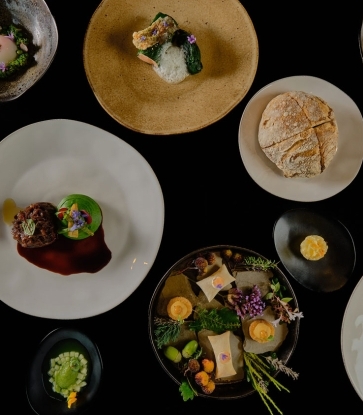The word “caper” may be traced back to the Greek word kapparis. The actual bush (Capparis Spinosa) is a small shrub with oval leaves, whose buds are harvested in the mornings, in May and June. Instead of being dried, they are pickled in oil, brine, or vinegar. Some experts believe that salted—not pickled—capers from the Italian islands of Pantelleria and Salina are far superior because one can taste the bud and not the brine. The smallest capers are non-pareilles; slightly larger are surfines. Both less than a quarter-inch in diameter, and are said to be more precious than the larger capucines.
Central to many Mediterranean dishes, capers are mostly used to enhance tomato- and wine-based sauces bobbing with poultry and fish. They're also in perfect harmony with herbs such as basil, oregano, flat leaf parsley, and mint. The addition of garlic, lemon, and olives delivers the most sublime combinations. Caperberries are the fruit of this shrub, which look like tiny (as slight as the nail on your little finger) zucchinis. For many, they are a substitute for capers to be used in dishes like insalata di riso con pomodoro, tonno e capperi—a rice salad tossed with tomato and tuna—or dropped into an ultra-dry martini. When cooking, this explosively flavorful bud should be saved for the very end, as even a dash of heat will destroy its aroma.

The cuisines of Central and Northern Europe also cherish the caper, as highlighted in the following dishes: sole à la Grenobloise, a classic French preparation combining sole, browned butter, lemon, and parsley. Just to the north, German specialty konigsberger klopse features meatballs in a creamy sauce. Over in Italy, salsa di capperi is a signature dressing from the Lombardy region, while Sicily showcases caponatina (eggplant relish) or sweet-and-sour rabbit with a sundried-tomato-and-caper paste. Working its way through Europe and all the way to America, this versatile bud also makes an appearance on the Jewish-American table, as a distinct component in the very classic and comforting bagel with lox and cream cheese.
These are some our favorite caper dishes from MICHELIN Guide restaurants in the US.
New York - Nolita, Manhattan
Pollo Emilio at Emilio’s Ballato. The chef’s name adds a bit of variation to the classic Italian American dish—chicken piccata. The chicken is thinly sliced, lightly dredged in flour, quickly sautéed, and finished with a lemon-caper sauce. The flour helps the flavors adhere to the fork-tender chicken, making this a savory, tart, fragrant, and deliciously simple preparation. A side of crusty sourdough is great for sopping up the sauce.
New York - Morris Park, Bronx
Spaghetti puttanesca at Enzo’s of Williamsbridge. This delicious sauce is composed with tomato, briny black olives, meaty capers, and a host of fresh herbs. Hit with spice from red chili pepper flakes and bursting with umami thanks to creamy anchovies, this is an ideal example of less is more. The flavors really gel, with the Rustichella d'Abruzzo spaghetti just delicately tossed in the heavenly sauce.
Chicago - Near North Side
Vitello tonnato at Nico Osteria. This is a twist on the original dish that swaps veal for tuna and tuna for veal in the sauce. The olive oil-poached tuna is meaty yet tender and topped with dabs of veal-enriched aioli, chopped capers, celery, and parsley. Shavings of crispy bead complete the plate.The combination of ingredients is fresh, flavorful, and balanced.
Hero image: capers. Photo © supermimicry/iStock





















